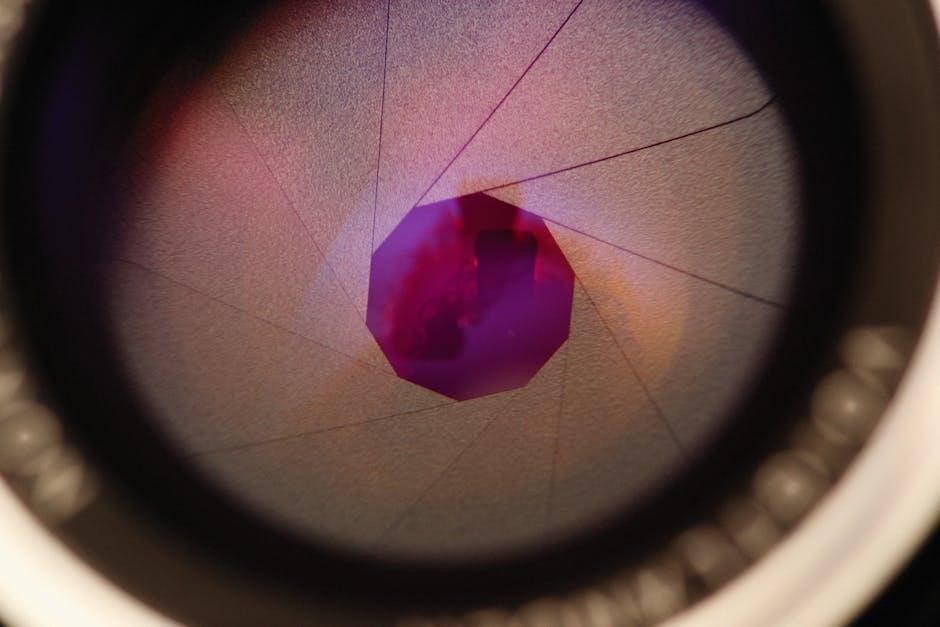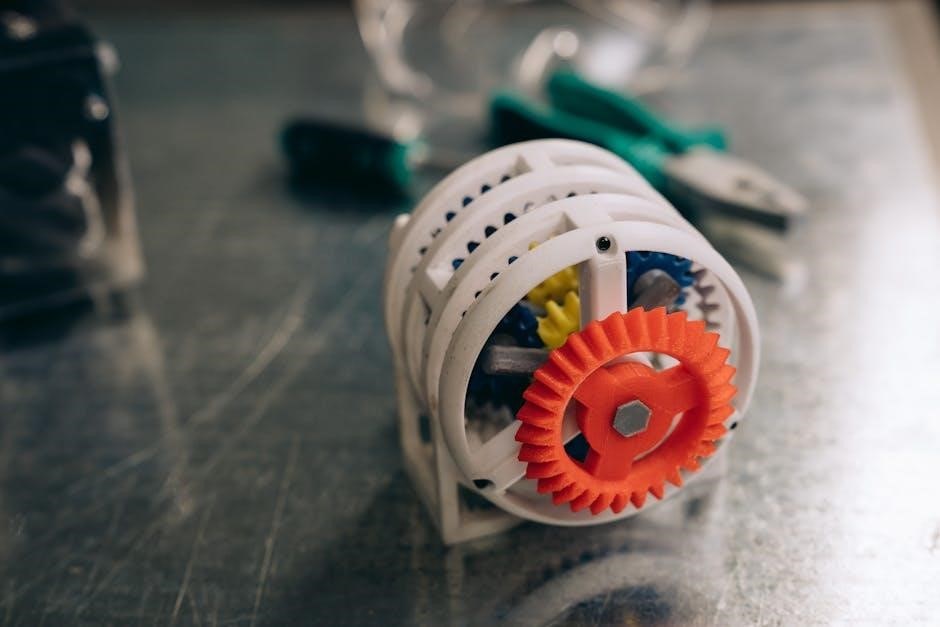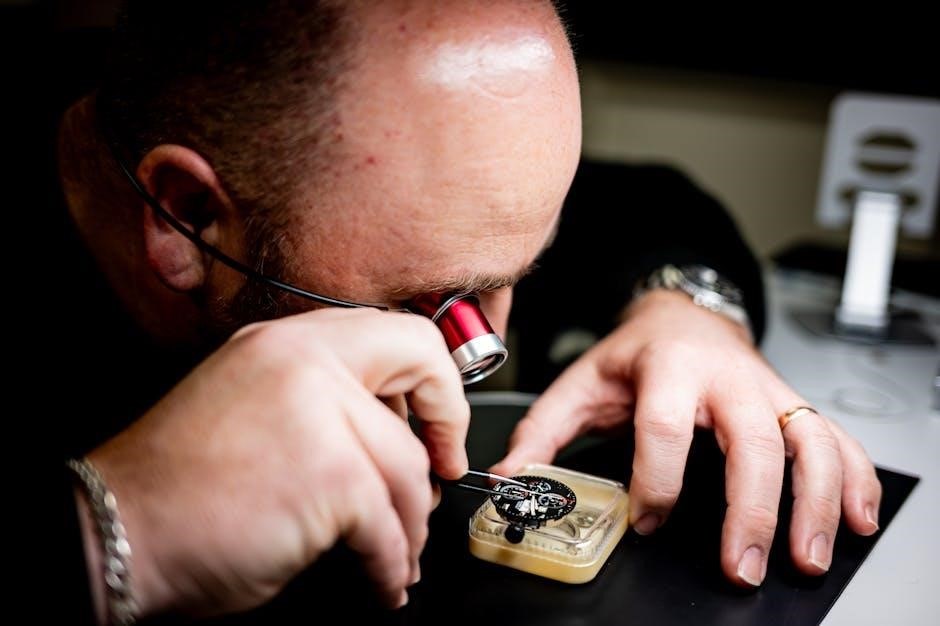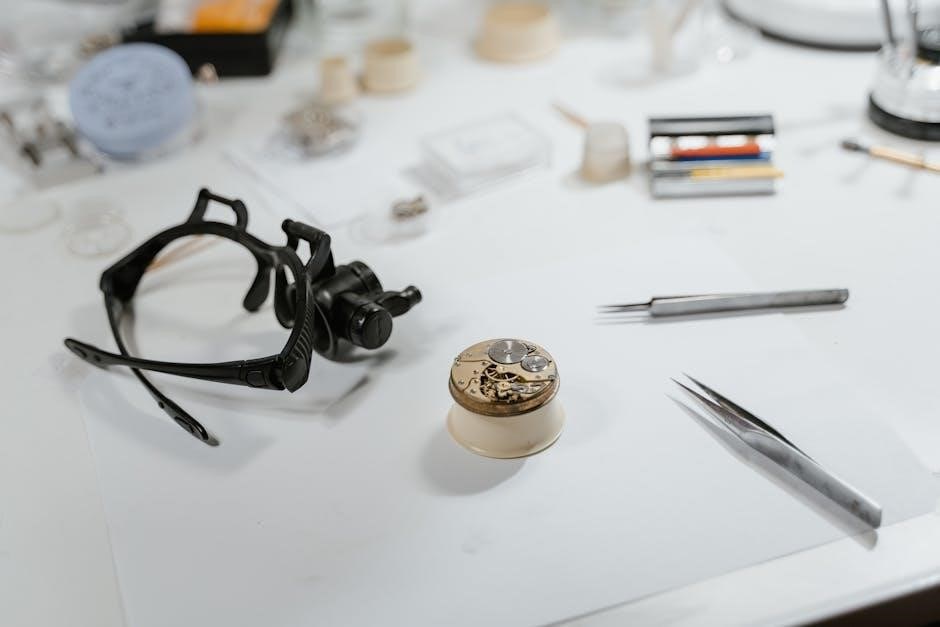Understanding microscope parts and functions is essential for effective use in scientific research, education, and medical diagnostics. This guide explores the key components, their roles, and significance in microscopy.
Overview of Microscope Components
A microscope is composed of several key components that work together to magnify and illuminate specimens. The primary optical parts include the objective lenses, eyepiece lenses, and condenser, which focus and direct light. Mechanical components such as the stage, focus knobs, and arm provide stability and precision for specimen handling. The illumination system, including the light source and diaphragm, ensures proper lighting. Additional features like the aperture and Abbe condenser enhance image clarity. Understanding these components is crucial for effective microscopy, as each part plays a specific role in achieving accurate and detailed observations.
Importance of Understanding Microscope Parts
Understanding microscope parts is vital for maximizing its functionality and ensuring accurate observations. Each component has a specific role, and improper use can lead to distorted images or damage to the instrument. Knowledge of microscope parts enables users to adjust settings appropriately, maintain the equipment, and troubleshoot common issues. This expertise is particularly important in scientific research, medical diagnostics, and education, where precise results are critical. Familiarity with the components also enhances efficiency, allowing users to focus on their work rather than navigating the instrument’s mechanics. Overall, comprehension of microscope parts is essential for optimal performance and reliable outcomes in various fields.

Optical Parts of the Microscope
The optical parts of a microscope, including the objective lenses, eyepiece lenses, and condenser, play a crucial role in magnifying and focusing light to produce clear images of specimens.
Objective Lenses and Their Functions
Objective lenses are crucial components of a microscope, responsible for collecting light from the specimen and forming an image. They are mounted on a rotating turret, allowing easy switching between different magnifications. Each objective lens has a specific numerical aperture, which determines its resolving power and ability to focus light. The most common objectives include 4x, 10x, 40x, and 100x magnifications. They are designed to work with the eyepiece to achieve the total magnification power of the microscope. Proper alignment and focus of the objective lenses are essential for obtaining clear and detailed images of specimens under examination.
Eyepiece Lenses and Their Role
Eyepiece lenses, also known as ocular lenses, are vital for observing the magnified image produced by the objective lens. Typically, they have a magnification power of 10x, though other magnifications like 5x or 15x are available. Eyepieces work in conjunction with objective lenses to achieve the total magnification of the microscope. They are designed to focus the light from the objective lens, creating a virtual image for the user to view. The eye relief (distance from the lens to the eye) ensures comfort during extended use. Eyepieces may also include reticles for measurements, enhancing their utility in educational and laboratory settings.
Condenser Lens and Its Purpose
The condenser lens is a critical component of the microscope’s illumination system. Its primary function is to focus and concentrate light from the light source onto the specimen. This ensures that the specimen is evenly illuminated, which is essential for obtaining a clear and well-defined image. Without the condenser lens, the image would appear dim and unclear. Some microscopes feature an Abbe condenser, which can be adjusted to optimize light transmission for different specimens and magnifications. By working in conjunction with the diaphragm, the condenser lens helps regulate the amount of light entering the microscope, significantly enhancing image quality and clarity.
Mechanical Parts of the Microscope
The mechanical parts of a microscope include the stage, focus knobs, and arm/base. These components provide stability, precise specimen positioning, and control over magnification adjustments, ensuring accurate observations.
Stage and Its Components
The stage is a platform where the specimen is placed for observation. It typically features stage clips to secure the slide and a mechanical stage for precise movement. Some microscopes have a stage plate with a hole to allow light to pass through. The stage is essential for maintaining the specimen’s position and enabling accurate focus. It often includes a rack stop to prevent over-focusing and damage to the objective lens. The stage’s design ensures stability and ease of use, making it a critical component for effective microscopy. Proper alignment and adjustment of the stage are vital for clear and detailed observations.
Focus Knobs (Coarse and Fine Adjustment)
The focus knobs are essential for adjusting the microscope’s focus. The coarse adjustment knob moves the stage up or down for initial focusing, while the fine adjustment knob makes precise adjustments for clarity. Together, they help achieve sharp, detailed images. Proper use ensures the specimen is centered and in focus, optimizing observation. These knobs are vital for user control and image quality, enabling accurate scientific and diagnostic work. Regular maintenance ensures smooth operation, while improper use can damage the microscope or distort images. Understanding their function is crucial for effective microscopy across various fields. Their interplay is fundamental to achieving optimal results.
Arm and Base of the Microscope
The arm connects the microscope’s base to the stage and optical components, providing structural support. The base houses the illumination system and stabilizes the instrument. Together, they ensure durability and balance, preventing vibrations during use. The arm’s design allows for easy handling, while the base’s weight enhances stability, crucial for precise observations. Proper alignment of the arm and base ensures the microscope functions optimally. Regular cleaning and inspection of these parts prevent damage, maintaining accuracy and longevity. Their robust construction is vital for reliable performance in laboratories and educational settings, making them foundational elements of the microscope’s design. Proper care ensures consistent functionality.
Illumination and Lighting System
The illumination system is crucial for microscope functionality, providing light through the condenser and diaphragm. It ensures even light distribution, enhancing image clarity and detail. Essential for optimal viewing.
Light Source and Its Importance
The light source is a fundamental component of a microscope, providing illumination for observing specimens. It ensures sufficient brightness and contrast, enabling clear visibility of microscopic structures. Modern microscopes often use LED or halogen bulbs for consistent, adjustable light. The quality of the light source directly impacts image clarity and detail, making it essential for accurate observations. Proper illumination prevents eye strain and enhances focus, while adjustable intensity allows customization for various samples. In brightfield microscopy, the light source is crucial for highlighting specimen details. Without adequate illumination, the microscope’s functionality is severely limited, emphasizing its critical role in microscopy.
Diaphragm and Its Function
The diaphragm is a crucial component of the microscope’s illumination system, regulating the amount of light entering the optical pathway. Located beneath the stage, it features adjustable apertures of varying sizes. By altering the aperture size, the diaphragm controls light intensity and contrast, optimizing image clarity. Proper adjustment ensures even illumination, preventing overexposure and enhancing specimen detail. The diaphragm works in conjunction with the condenser to focus light effectively. Its precise control is essential for achieving sharp, well-illuminated images, making it indispensable for accurate microscopic observations across various applications in biology, medicine, and materials science.
Additional Components of the Microscope
Additional components like the aperture, Abbe condenser, and light source enhance microscope functionality. These parts work together to improve image clarity, focus, and overall performance during observations.
Aperture and Its Role
The aperture is a critical component of the microscope, regulating the amount of light that enters the optical system. Located in the condenser, it adjusts the light intensity and focuses it onto the specimen. By controlling light entry, the aperture enhances contrast and reduces glare, ensuring clearer images. Proper adjustment of the aperture is essential for optimal microscopy, as it directly impacts the quality of the observed specimen. This feature is vital for achieving precise focus and maximizing the resolution of the microscope, making it indispensable in scientific research and education.

Abbe Condenser and Its Significance
The Abbe condenser is a fundamental accessory in microscopy, designed to focus and direct light onto the specimen. Named after Ernst Abbe, it enhances image clarity by concentrating light through the specimen. Its adjustable iris diaphragm regulates light intensity and ensures even illumination. Proper alignment of the Abbe condenser is crucial for achieving high-resolution images. It eliminates glare and ensures optimal light transmission, making it indispensable for precise observations. This component is essential for maintaining image quality and is widely used in biological and medical microscopy. Its significance lies in its ability to improve contrast and resolution, aiding accurate specimen analysis.

Functions of Each Microscope Part
Each microscope part plays a distinct role in achieving clear and precise image formation. Components work together to focus light, adjust magnification, and maintain specimen stability for optimal observation.
How Each Component Contributes to Image Formation
The objective lenses collect and focus light from the specimen, determining resolution and magnification. The eyepiece further enlarges the image produced by the objective. The condenser aligns light for even illumination, while the stage holds the specimen in place. Focus knobs adjust the distance between lenses and specimen for clarity. The illumination system provides light, and the diaphragm regulates its intensity. Together, these parts ensure proper light transmission, focus, and magnification, creating a clear and detailed image for accurate observation and analysis under the microscope.
Interdependence of Parts for Optimal Performance
The microscope’s components function interdependently to achieve optimal performance. Objective lenses and eyepieces work together to magnify specimens accurately, while the condenser and light source ensure proper illumination. The stage and focus knobs position and align the specimen precisely. If any part fails, such as inadequate lighting or misaligned lenses, image clarity suffers. This interdependence highlights the importance of each component working in harmony; Regular maintenance and adjustment of these parts are crucial to ensure the microscope operates effectively, delivering clear and precise images for accurate scientific observations and analysis.

Maintenance and Care of Microscope Parts
Regular cleaning, proper handling, and storage are crucial for maintaining microscope parts. Use soft cloths and specialized cleaning solutions to avoid damaging lenses and surfaces. Store the microscope in a dry, cool place to prevent rust and fungus growth; Always follow the manufacturer’s guidelines for maintenance to ensure optimal performance and longevity of the instrument.
Best Practices for Cleaning and Handling
Always handle microscope parts with clean, dry hands or gloves to prevent oil residue. Use soft, lint-free cloths and specialized cleaning solutions to avoid scratching surfaces. For lenses, only use manufacturer-recommended cleaning tissues to prevent damage. Avoid harsh chemicals or abrasive materials that can harm coatings or optical surfaces. Regularly inspect and clean the stage, focus knobs, and other mechanical parts to ensure smooth operation. Store the microscope in a cool, dry place to prevent moisture damage. Never touch lens surfaces directly, as fingerprints can degrade image quality. Proper handling and cleaning routines extend the lifespan of the microscope and maintain its performance.
Common Issues and Troubleshooting
Common microscope issues include blurry images, poor illumination, or mechanical malfunctions. Blurry images often result from incorrect focus, dirty lenses, or improper sample preparation. Poor illumination may stem from a misaligned condenser, incorrect light intensity, or a faulty light source. Mechanical issues, such as sticky focus knobs or stage movement problems, can arise from lack of lubrication or wear. Contamination on lenses or the stage can also degrade image quality. Regular cleaning, proper alignment, and timely maintenance can resolve many of these issues. For persistent problems, consulting the microscope manual or seeking professional repair is recommended to ensure optimal performance.
Understanding microscope parts and their functions is crucial for effective microscopy; Each component plays a vital role in image quality and functionality, emphasizing the importance of proper care and maintenance.
Key Takeaways About Microscope Parts and Functions
The microscope is a complex tool with specialized parts working together to produce magnified images. Objective lenses focus light, eyepieces enlarge images, and the condenser optimizes illumination. The stage holds specimens securely, while focus knobs adjust clarity. Proper maintenance ensures longevity and functionality. Understanding each component’s role enhances microscopy skills and image quality. Regular cleaning and troubleshooting prevent common issues. Familiarity with these parts is essential for effective use in scientific research, education, and medical diagnostics, making microscopes indispensable tools in various fields.



